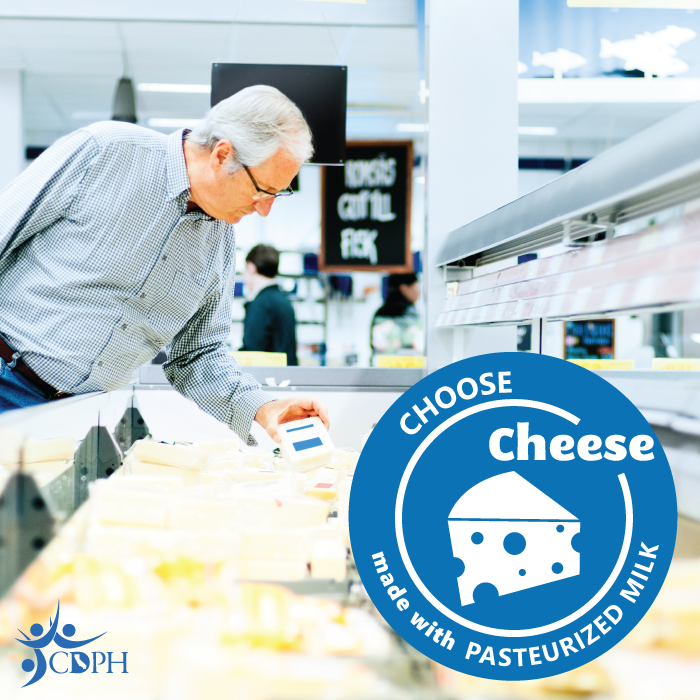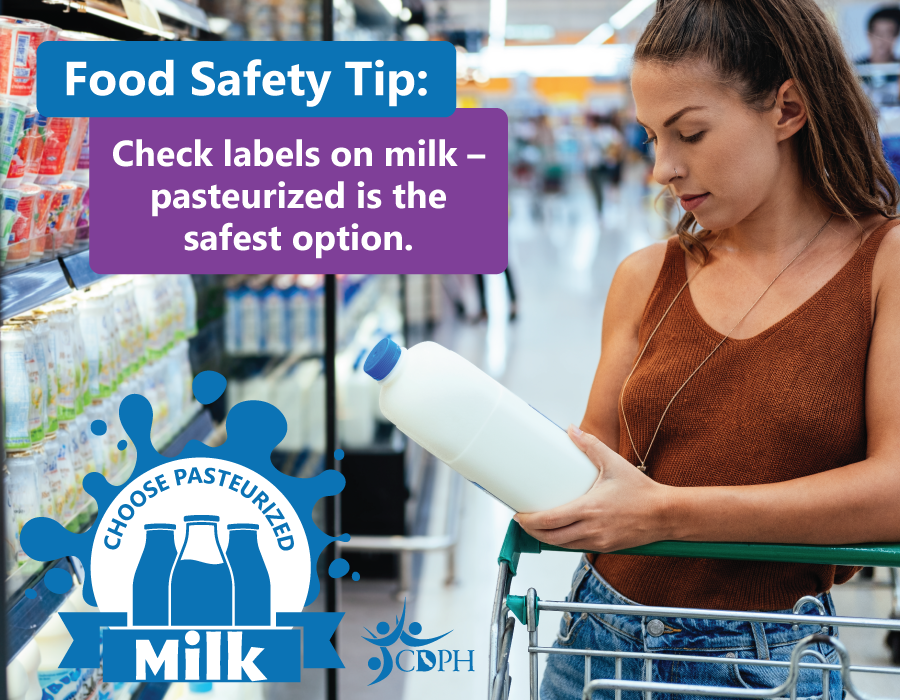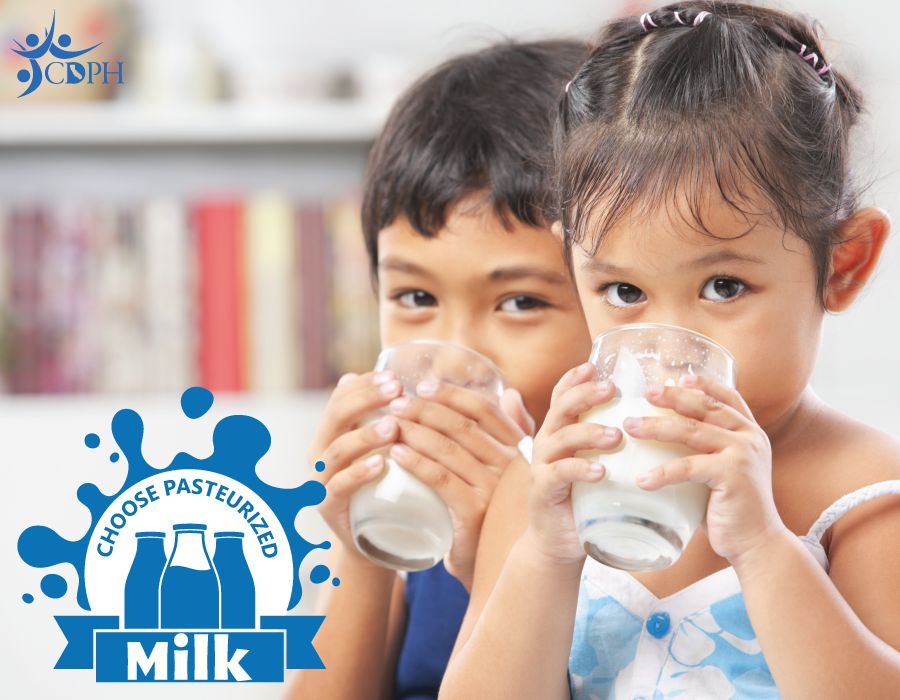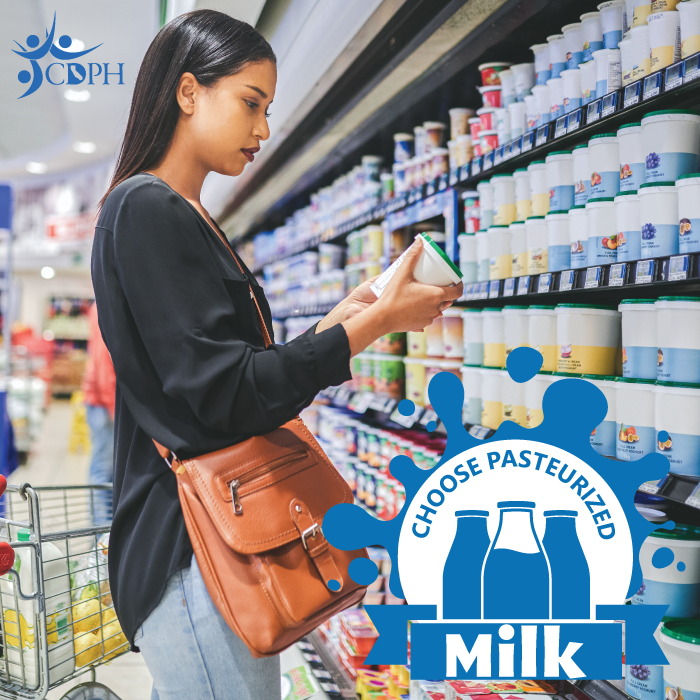English
|
Spanish
|

-
Raw milk and dairy products made with raw milk can be contaminated with animal poop germs that can cause food poisoning and other serious illnesses. Some people, especially children, may even need hospital care because they got sick from raw milk. The best way to stay safe? Choose #pasteurized milk and cheese! https://go.cdph.ca.gov/rawmilk
-
Raw milk and food made with raw milk may be contaminated with germs that cause food poisoning. Some people, especially children, may need hospital care because of raw milk. Stay safe, choose pasteurized milk and cheese! go.cdph.ca.gov/rawmilk
#RawMilk #ChoosePasteurized #MilkSafety
|

-
La leche cruda y los productos lácteos elaborados con leche cruda pueden contener gérmenes que pueden causar intoxicaciones alimentarias y otras enfermedades graves. Algunas personas, especialmente los niños, pueden requerir atención hospitalaria por enfermedades a causa del consumo de leche cruda. ¿Cuál es la mejor manera de protegerse? ¡Eligiendo leche y queso pasteurizados! go.cdph.ca.gov/rawmilk
-
La leche cruda y alimentos elaborados con leche cruda pueden estar contaminados con gérmenes que causan intoxicación alimentaria. Niños, especialmente, pueden requerir de hospitalización debido al consumo de leche cruda. go.cdph.ca.gov/rawmilk
#LecheCruda #EscogePasteurizacion #LecheSaludable
|

-
Why is pasteurization important? Pasteurization is the process of heating beverages and dairy products (like milk) to kill harmful germs that can make you sick. Symptoms of illness from raw milk can include fever, headache, diarrhea, stomach cramps, and vomiting. In some cases, more severe outcomes can lead to paralysis, kidney failure, stroke, miscarriage, or even death.
To protect yourself and your family, choose dairy products that state on the label that they are pasteurized. Learn more: go.cdph.ca.gov/rawmilk
-
Pasteurization is the process of heating foods and beverages (like milk) to kill harmful germs that can make you sick. To protect yourself and your family, choose dairy products that state on the label that they are #pasteurized. Learn more: go.cdph.ca.gov/rawmilk
#RawMilk #ChoosePasteurized #MilkSafety
|

#LecheCruda #EscogePasteurizacion #LecheSaludable
|

-
Did you know there are health risks with drinking raw milk? Germs in raw milk can make some people very sick, especially young children (less than 5 years old), pregnant people, and people with weakened immune systems. For the safety of your family, choose pasteurized milk! Learn more: go.cdph.ca.gov/rawmilk
-
Did you know there are health risks with drinking raw milk? Germs in raw milk can make some people
very sick, especially
young children and people with weakened immune systems. For your safety, choose pasteurized milk! go.cdph.ca.gov/rawmilk
#RawMilk #ChoosePasteurized #MilkSafety
|

|

Just because a dairy product
is called "raw"
doesn't mean
it's better for you than milk or cheese that is pasteurized. There are no scientifically proven health benefits of drinking raw milk, but there are many well documented risks. Choosing pasteurized milk and dairy is the best way to safely enjoy the nutritional benefits of milk. Learn more: go.cdph.ca.gov/rawmilk
There are no scientifically proven health benefits of drinking raw milk, but many well documented risks. Choosing pasteurized milk and dairy is the best way to safely enjoy the nutritional benefits of milk. go.cdph.ca.gov/rawmilk
#RawMilk #ChoosePasteurized #MilkSafety
|

-
El hecho de que un producto lácteo
indique que
está “crudo" no significa que sea mejor para
la
salud que la leche o el queso pasteurizado.
No existen beneficios para la salud científicamente probados por beber leche cruda, pero
sí existen riesgos bien documentados por beber leche cruda. Elegir leche pasteurizada y productos lácteos
pasteurizados
es la mejor manera de disfrutar de
forma
segura los beneficios nutricionales de la leche.
Infórmate
más: go.cdph.ca.gov/rawmilk
-
No existen beneficios para la salud científicamente probados por beber leche cruda, pero sí existen riesgos bien documentados por beber leche cruda. go.cdph.ca.gov/rawmilk
#LecheCruda #EscogePasteurizacion #LecheSaludable
|
-
You may prefer buying foods that
aren’t processed, but some food processing
actually helps keep people safe. Cooking is a type of processing that helps destroy germs in food like raw meat without altering its nutritional value.
Similarly, milk
is pasteurized to kill harmful germs that can make people sick. go.cdph.ca.gov/rawmilk
#RawMilk #ChoosePasteurized #MilkSafety
|
-
Quizás prefieras alimentos que no estén procesados,
pero de hecho, el procesamiento de algunos alimentos ayuda a mantener a la gente sana.
La cocción es un tipo de procesamiento que ayuda a destruir los gérmenes en alimentos como la carne cruda sin alterar su valor nutricional. Del mismo modo, la leche se pasteuriza para matar los gérmenes dañinos que pueden enfermar a las personas. go.cdph.ca.gov/rawmilk
-
Quizás prefieras alimentos que no estén procesados,
pero de hecho, el procesamiento de algunos alimentos ayuda a mantener a la gente sana.
Cocinar carne cruda destruye los gérmenes y la leche se pasteuriza para matar los gérmenes dañinos
que causan enfermedades. go.cdph.ca.gov/rawmilk
#LecheCruda #EscogePasteurizacion #LecheSaludable
|